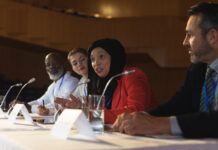
The meetings and events industry has doubled down on its DEI efforts in recent years. The question is, are meetings actually getting more diverse, equitable and inclusive?
Being in the hospitality industry, one would think the meetings and events industry would be at the forefront of the diversity, equity and inclusion (DEI) movement. But with distractions ranging from increasing costs and stagnant budgets to insufficient staffing on both planner and venue sides, what is the status of DEI now in this industry?

Solomon Herbert, Owner of Black Meetings & Tourism magazine, which has covered African American conventions, incentives and leisure travel for two decades, pointed out that there still is a need for more diverse representation in leadership positions on the hospitality side. While he said he doesn’t believe the omission of African Americans and other people of color at the top of U.S. convention and visitors bureaus (CVBs) and destination marketing organizations (DMOs) is intentional, there still are only 11 people of color at the helm, out of more than 700 CVBs in the U.S. “That is abysmal in terms of diversity in leadership for hospitality and travel in this country.” Some of this dearth may stem from a lack of people of color in the hospitality leadership pipeline — at least, those who are senior enough to be considered for the top slots. “There’s a lot of room for improvement,” he noted.
Herbert said that it’s important to just ask people what they would need to feel included and welcomed. And to show, not tell, that people from underrepresented groups belong at your meetings, events, hotels, etc. This means advertising in media aimed toward those demographics, he added. “According to our research, less than 4% of destinations advertise in Black-owned media. If you want to say they’re welcome, they need to invest in those markets.” Marketing and collateral materials also should show the full range of demographics you want to attract and highlight activities and extracurricular programming that would be of interest to them, he said. And include people of color on your planning committees who can provide input on programming and activities that would make people of their background feel comfortable and welcome.
One powerful way to bring in diverse voices is to ask your staff, volunteers and members to share their stories. For example, to celebrate Black History Month at meetings being held in February, ask people to tell a story about their Black history.
Remember that DEI work is an evolution, not a one-time thing or a box you can check off. And it will continue to evolve, especially since the U.S. workforce is poised to change significantly over the next three to five years. Boomers are leaving the workforce, and in a few years are expected to just make up 6% or 7% of the total, while Gen Z in a few years will be closer to a quarter or a third of your group.
Some resources:
- Institute for Diversity Certification, which provides training and certification in effective DEI practices.
- The Diversity Movement, which partners with organizations to build and strengthen culture by connecting real-world business outcomes to diversity, equity, and inclusion (DEI) initiatives
- National Coalition of Black Meeting Professionals, a national nonprofit dedicated primarily to the training needs of African American meeting planners, as well as the improvement of the meetings, conferences, exhibitions and conventions they manage.
- Meeting Professionals International has an Equality and Justice resource section rich in podcasts, chapter resources, videos, movies/documentaries, and other tools and materials
- Professional Convention Management Association has Ascent Resources, which includes on-demand sessions and webinars to help coach more inclusive practices
- American Society of Association Executives has a Diversity & Inclusion section that offers research, tools and resources
You May Also Be Interested In…
The Collective Experience: Making Progress in DEI










